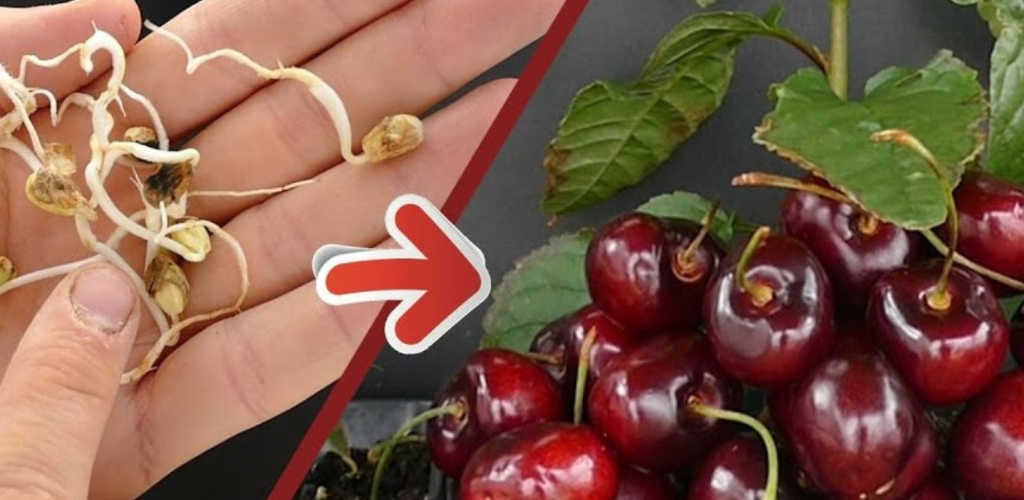Plant and grow a cherry tree successfully
1. Choose the right cherry tree for your garden
Choosing the perfect cherry tree for your yard depends on several factors, including the size of your space, the climate, and your personal tastes and appearance preferences.
There are two main types of cherry trees: sweet cherry trees ( Prunus avium ) and sour cherry trees ( Prunus cerasus ). Sweet cherry trees produce sweet fruits and are generally grown for human consumption, while sour cherry trees are more often used for cooking and baking.
Sweet cherry trees are generally taller than sour cherry trees, often reaching a height of 6 to 10 m. They also need warmer weather to bear good fruit. Popular varieties of sweet cherry trees include the famous ‘Bing’, ‘Rabbits’, ‘Rainier’ and ‘Sweetheart’.
Sour cherry trees , on the other hand, are smaller trees, typically reaching a height of 4 to 12 m. They are more cold tolerant and can be grown in more northern regions. Well-known varieties of sour cherry trees include ‘Montmorency’, ‘Morello’ and ‘North Star’.
Once you’ve decided on the right type of cherry tree for your garden, consider pollination. Some cherry trees are self-fertile and can produce fruit without another pollinator tree nearby. Other cherry trees need a compatible pollinator tree to produce fruit. Carefully read the information provided by the nursery or seedling supplier to choose appropriate trees.
2. When and how to plant a cherry tree
The best time to plant a cherry tree is in fall or spring, when the soil is moist and temperatures are mild.
This gives the tree time to establish itself and develop a strong root system before the hot, dry seasons. These are the steps to follow to plant a cherry tree:
- Choose a sunny location – Cherry trees need plenty of sun to grow well. Choose a planting site that receives at least 6 hours of direct sunlight per day.
- Prepare the soil : Cherry trees prefer well-drained, fertile, slightly acidic soil (pH 6.0-6.5). If your soil is heavy and clayey, you can improve it by adding compost, peat moss, and coarse sand.
- Dig a planting hole : The hole should be twice as wide as the root ball and a little deeper. Place the cherry tree in the hole so that the graft line (the junction between the rootstock and the fruiting variety) is one inch above ground level.
- Fill the hole and water thoroughly : Fill the hole with the prepared soil mixture, tamping lightly to remove air pockets. Water the tree well so that the water reaches the roots and removes any remaining air pockets.
- Mulch and protect : Apply a layer of mulch (such as wood chips or shredded leaves) around the base of the tree to help retain moisture and prevent weed growth. Place a stake or stake to support the tree and protect its trunk from strong winds and animals.
3. Maintenance and care of the cherry tree
A well-maintained cherry tree is essential to ensure a bountiful harvest and healthy growth.
Here are some tips for caring for your cherry tree:
- Watering : Young cherry trees need regular watering to establish a strong root system. Water them weekly for the first year, adjusting the frequency based on weather conditions. Once established, cherry trees can tolerate dry periods, but regular watering during dry periods is recommended to ensure a bountiful harvest.
- Fertilization : Cherry trees benefit from annual fertilization to support growth and fruit production. Apply a balanced fertilizer (such as a 10-10-10) in early spring, before the tree begins to bloom.
- Pruning : Pruning cherry trees is essential to maintain a balanced shape, encourage fruiting, and prevent disease. Prune cherry trees in winter, when they are dormant, removing dead, diseased or crossing branches. Also thin branches to allow good air circulation and light penetration.
- Protection against pests and diseases : Cherry trees can be susceptible to various pests and diseases, such as aphids, spider mites, monilia and gummosis. Regularly inspect your tree for signs of problems and treat them immediately with appropriate biological or chemical methods.
By following these tips and techniques, you will be well equipped to plant, grow, and maintain a cherry tree in your garden. The result ? A beautiful and productive tree that will provide you with delicious cherries for many years. So don’t wait any longer, choose your ideal cherry tree and start planting today!
